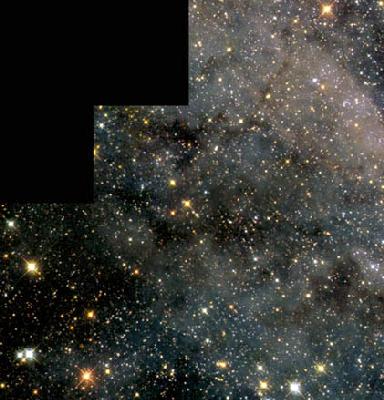A young star is speeding away from the Milky Way so fast that astronomers have been puzzled by where it came from; based on its young age it has traveled too far to have come from our galaxy. Now by analyzing its velocity, light intensity, and for the first time it tell-tale elemental composition, Carnegie astronomers Alceste Bonanos and Mercedes Lopez-Morales, and collaborators Ian Hunter and Robert Ryans from Queen’s University Belfast have determined that it came from our neighboring galaxy, the Large Magellanic Cloud (LMC). The result suggests that it was ejected from that galaxy by a yet-to-be-observed massive black hole.
The star, dubbed HE 0437-5439, is an early-type star and one of ten so-called hypervelocity stars so far found speeding away from the Milky Way. “But this one is different from the other nine,” comments Lopez-Morales. “Their type, speed, and age make them consistent with having been ejected from the center of our galaxy, where we know there is a super-massive black hole. This star, discovered in 2005, initially appeared to have an elemental makeup like our Sun’s, suggesting that it, too, came from the center of our galaxy. But that didn’t make sense because it would have taken 100 million years to get to its location, and HE 0437-5439 is only 35 million years old.”
To explain the enigma, or “paradox of youth,” the discoverers proposed that HE 0437-5439 was either a so-called blue straggler, a relatively young, massive star resulting from the merger of two low-mass stars from the Milky Way, or it originated from the LMC.
“We were intrigued by the conundrum and decided to take up the challenge to solve this,” states Bonanos. “Stars in the LMC are known to have lower elemental abundances than most stars in our galaxy, so we could determine if its chemistry was more like that galaxy’s or our own.”
The team confirmed results of the previous study concerning the mass, age, and speed of the star. It is about 9 times the mass of our Sun, about 35 million years old, and it is zooming away from the Milky Way and the LMC into intergalactic space at 1.6 million miles per hour (2.6 million km/hour).
Although the previous study was able to roughly estimate the star’s elemental composition, the measurements were not detailed enough to determine if the elements match stars in our galaxy, or are characteristic of stars from the LMC. These astronomers were able to measure the relative abundances of certain elements for the first time in any hypervelocity star. The relative abundance of key elements tells them where a star originated.
“We’ve ruled out that the star came from the Milky Way,” explains Bonanos. “The concentration of elements in the LMC stars are about half those in our Sun. Like evidence from a crime scene, the fingerprints point to an origin in the LMC.”
Based on the speed of the star’s rotation measured by the discoverers, and confirmed by this team, the astronomers believe that the star was originally part of a binary system. The binary could have passed close to a black hole 1,000 the mass of the Sun. As one star was pulled into the black hole, the other was whipped into frenzy and flung out of the galaxy.
“This is the first observational clue that a massive black hole exists somewhere in the LMC. We look forward to finding out where this black hole might be,” concludes Bonanos.










